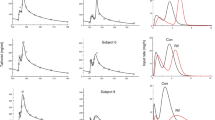Summary
Amicakin levels in serum and tissues were determined in 115 Wistar rats, 70 with normal renal function (NRF) and the remaining 45 with terminal renal impairment (TRI). The results obtained in the animals with NRF show an accumulation of the antibiotic in all the tissues studied as compared with plasma levels, specially in the renal cortex and medulla. In the rats with TRI important alterations in the plasma and tissue kinetics of the antibiotics were observed. The plasma kinetics of amikacin in rats with TRI are characterised by significant alterations in the pharmacokinetic parameters, specially those defining the distribution processes of the antibiotic. In the tissues of the latter, a significant increase in the antibiotic concentration takes place, particularly in the renal cortex. The average halflives of the antibiotic in the tissues of rats with TRI increase compared with the group of rats with NRF, though the difference are not so significant as in the case of the plasma half-life.
The use of a specific kinetic distribution model, with linear and non-linear tissue binding, showed that significant variations occur in the partition coefficient and in the Michaelis-Menten parameters, which characterize the saturable binding of Amikacin to tissue in rats with NRF and TRI.
Similar content being viewed by others
References
Welling P.G., Craig W.A. (1976): In Benet L.Z. (ed) ‘The effect of disease states on drug pharmacokinetics’. Washington American Pharmaceutical Association, pp. 155–187.
Carbon C., Contrepois A., Lamotte-Barrillon S. (1978): Comparative distribution of gentamicin, tobramycin, sisomicin, netilmicin and amikacin in interstitial fluid in rabbits. Antimicrob. Agents Chemother.13, 368–372.
Schentag J.J., (1978): Accumulation des aminosides dans le parenchyma renal. Nouv. Presse Med.7, 3824–3829.
Rudhart M., Blanchard P., Fabre J. (1978): Accumulation et persistence des aminosides dans le parenchyma renal. Nouv. Presse Med.7, 3819–3823.
Mondorf A.W. (1978): Action des aminosides et des cephalosporins sur le tube proximal du rein human. Nouv. Presse Med.7, 3835–3837.
Rudhart M., Fabre J. (1979): Behaviour of amikacin in renal parenchyma of normal rats with acute obstructive renal insufficiency. Nephron.24, 287–291.
Flamenbaum W., Huddieston U.L., McNeil H.S., Hamburger R.J. (1974): Uranyl nitrate-induced acute renal failure in the rat: Micropuncture and renal hemodynamic studies. Kidney Int.6, 408–418.
Hewitt W. (1977): In ‘Microbiological Assay: An introduction to quantitative principles and evaluation’. New York, Academic Press Inc., pp. 17–101.
Metzler C.M., Elfring L.G., McEwen A.J. (1974): A package of computer program for pharmacokinetics modeling. Biometrics30, 512–513.
Wagner J.G. (1975): In ‘Fundamentals of clinical pharmacokinetics’. Hamilton, Illinois. Drug Intelligence Publications Inc. pp. 82–90.
Walker J.M., Wise R., Mitchard M.J. (1979): The pharmacokinetics of amikacin and gentamicin in volunteers: A comparison of individual differences. J. Antimicrob. Chemother.5, 95–99.
Mahon W.A., Inaba T., Ezer J.I. (1975): Studies using tritiated amikacin. Syracuse, New York. Bristol Laboratories Files, p. 13201.
Koeda T., Umemura K., Yokota M. (1982): In Umezawa H., Hooper I.R. eds. ‘Aminoglycoside Antibiotics’. Berlin-Heidelberg-New York. Springer-Verlag.62, pp. 293–356.
Schentag J.J., Jusko W.J., Vance J.W., Cumbo T.H., Abrutyn E., Delattre M., Gerbracht L.M. (1977): Gentamicin disposition and tissue accumulation in multiple dosing. J. Pharmacokinet. Biopharm.5(6), 559–579.
Kornguth M., Kunin C. (1977): Distribution of gentamicin and amikacin in rabbit tissues. Antimicrob. Agents Chemother.12, 974–977.
Ditter L.W. (1976): Pharmacokinetics of aminoglycosides: General considerations. U.S. Amikacin Symposium. Am. J. Med. pp. 77–83.
Trouet A., Tulkens P. (1981): In Ninet L., Bost P. E., Bouanchaud D.H., Florent J. eds. ‘The future of antibiotherapy and antibiotic research’ London Academic Press Inc. pp. 337–349.
Wagner J.G. (1973): Properties of the Michaelis-Menten equation and its integrated form which are useful in pharmacokinetics. J. Pharmacokinet. Biopharm.1, 103.
Author information
Authors and Affiliations
Rights and permissions
About this article
Cite this article
Alonso, I.G., Lanao, J.M., Saez, M.C. et al. Non-linear tissue binding of amikacin in rats: the effect of renal impairment. European Journal of Drug Metabolism and Pharmacokinetics 12, 193–201 (1987). https://doi.org/10.1007/BF03189897
Received:
Issue Date:
DOI: https://doi.org/10.1007/BF03189897




